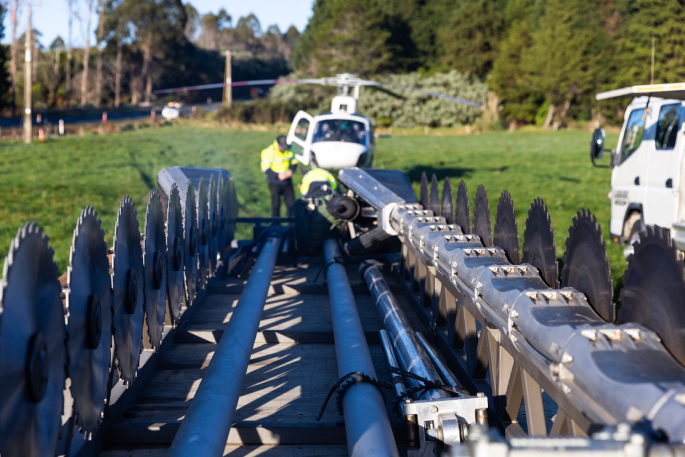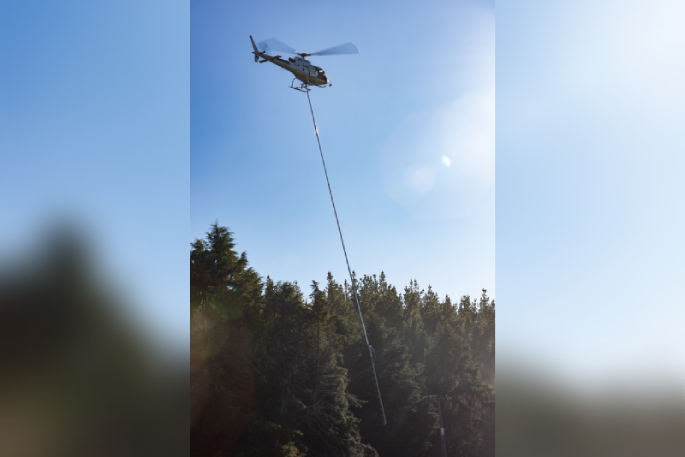Powerco is trialling an innovative approach to managing trees next to its power lines - using a tree-trimming saw suspended below a helicopter.
The energy distribution company this week successfully completed cutting trees in a forestry block, adjacent to SH33 Paengaroa in western Bay of Plenty, that were growing too close to power lines supplying a communications tower.
Trees in lines cause one in four power cuts on Powerco’s network.
"When overgrown, trees can interfere with power lines, cause outages and make it difficult for crews to restore power,” says Powerco General Manager Electricity Karen Frew.
“Overgrown trees and vegetation are a major cause of power outages, particularly during storms."

Karen says the overhead power lines network is vast, spanning thousands of kilometres of rural lines supplying power to remote communities.
“Falling trees and branches in forestry blocks contribute to a significant number of faults on our network, ultimately cutting power to our rural communities," says Karen.
"We’re trialling the heli-saw to see if we can remove risk to remote power lines, while saving time and money for the benefit of our customers.”
During 2023, electricity lines companies in New Zealand spent more than $58 million on vegetation management including pruning and felling trees that obstructed lines and infrastructure. This cost is making electricity more expensive for electricity consumers.
“In the Paengaroa trial, in just one hour, the heli-saw successfully cut an 800m-stretch of forestry block – that's 160 trees - adjacent to a section running alongside the road, saving days of work and thousands of dollars,” say Karen.
“We have a number of ways in which we manage trees on our network and the heli-saw is a valuable tool.
"We'll look to use the heli-saw again, mostly to maintain clearance corridors - 20m each side of the lines - in forestry blocks. Falling trees and branches in forestry blocks contribute to a number of faults on the Powerco network.”
 A tree-trimming saw suspended below a helicopter. Photo: Supplied.
A tree-trimming saw suspended below a helicopter. Photo: Supplied.
To enable the work to be carried out safely, the power lines along the cut zone on SH33 were disconnected and dropped to the ground while the aerial cutting was undertaken.
Traffic management was also in place, with traffic being stopped at a safe distance in both directions for 10-minute periods while the helicopter worked.
It took two runs for the entire length of pine trees to have their branches cut back to the trunk.
“Thank you to those who were stopped for short periods from travelling along the road while the work was being carried out above,” says Karen..
Lakeview Helicopters is the only heli-saw operator in New Zealand with CAA approved equipment. It uses a CAA approved stabiliser pole system to connect the saws to its H125 B3E and AS350 B2 helicopters.
That system removes the saws’ ability to turn and rotate, improving the safety and controllability of the equipment by the pilots. The saw blades, operating at 2000 rpm, can cut branches up to 25 centimetres in diameter.
Other ways Powerco is advancing its vegetation management include:
- Employing a dedicated forestry manager to enhance collaboration with forestry owners, particularly with the emergence of carbon forestry.
- Exploring the use of up to date satellite imagery to better understand growth rates and high-risk trees.
- Identifying out-of-zone vegetation using LiDARinformation that could impact the network during adverse weather.
Powerco is New Zealand’s second largest electricity and gas distribution utility with over 900,000 customers (across 457,000 connections) connected to its networks.
Powerco’s electricity networks are in Western Bay of Plenty, Thames, Coromandel, Eastern and Southern Waikato, Taranaki, Whanganui, Rangitīkei, Manawatū and the Wairarapa. Its gas pipeline networks are in Taranaki, Hutt Valley, Porirua, Wellington, Horowhenua, Manawatū and Hawke’s Bay



0 comments
Leave a Comment
You must be logged in to make a comment.